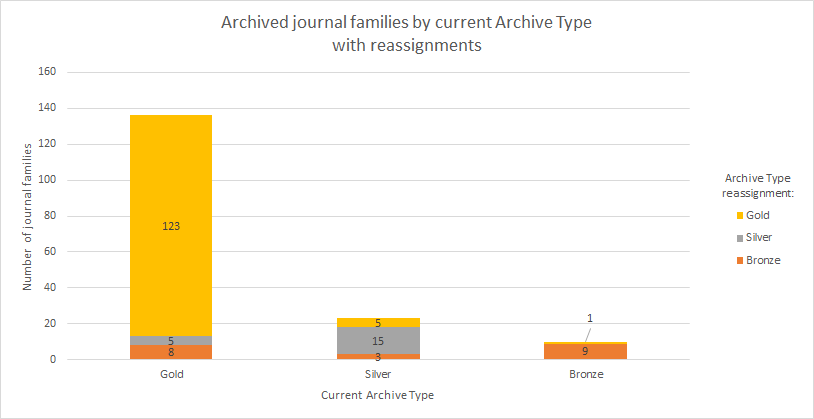Analysis sheds light on changes in journal risk level over time
As the collection analysis progresses, the WEST project team has been performing some additional lightweight analyses to investigate points of interest that came to light in the 2019 program assessment. WEST has not historically performed any retrospective reviews of archived journals to track how electronic availability changes over time, but an opportunity to analyze a small data set for this purpose arose during the current collection analysis.The analysis inadvertently included a small number of journals that have already been archived for WEST and revealed that a percentage of those journals has since jumped archives types based on the most current electronic availability information. In total, this impromptu sample included 169 journal families.
Of the 169 journal families included in this sample, 22 (13%) were assigned to title categories that correspond to different archive types than under which they were originally archived. Sixteen of the journal families that were ‘reassigned’ moved from title categories indicating low or no electronic presence to those with greater and more reliable digital coverage. While this data set is very small, the indication that journals that were once considered ‘high risk’ now have expanded electronic access–and in most cases highly reliable electronic access–exposes the ongoing digitization work that is so valuable in today’s current reality of extremely limited access to print materials.That WEST has print backups that have gone through rigorous physical validation reinforces the overall reliability of these digital repositories: the print archive can be used to correct any mis-scans that may be present, or could be used as the basis for new or expanded digitization projects to make high-risk materials more readily accessible to more researchers.
The following chart shows the journal families by current Archive Type (x-axis), broken down by Title Category reassignment found in this analysis (color):

Two curious things to note: five journal families that are currently archived as Silver and one journal family that is currently archived as Bronze came out of this analysis designated as Gold. The Silver journal families that are now Gold could have been on a database title list that we were not able to obtain in the current collection analysis. The Bronze title that got a “Gold” designation in this analysis appears to have been queued for archiving by Portico during the Cycle 8 analysis, and has since been preserved but under a different ISSN. This illustrates the difficulty in identifying changes in standard numbers as well as the potential consequences of not being able to track these changes.
